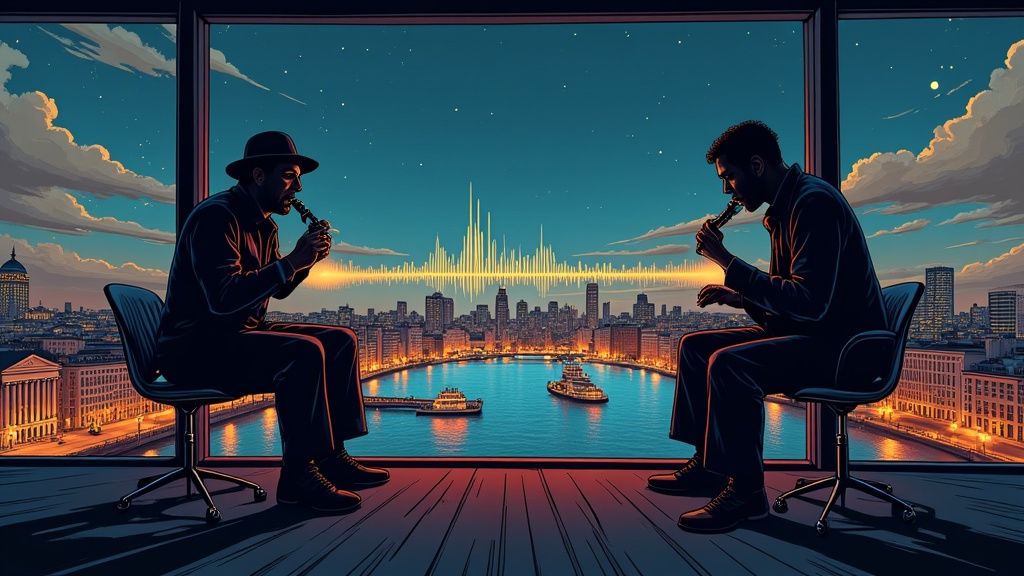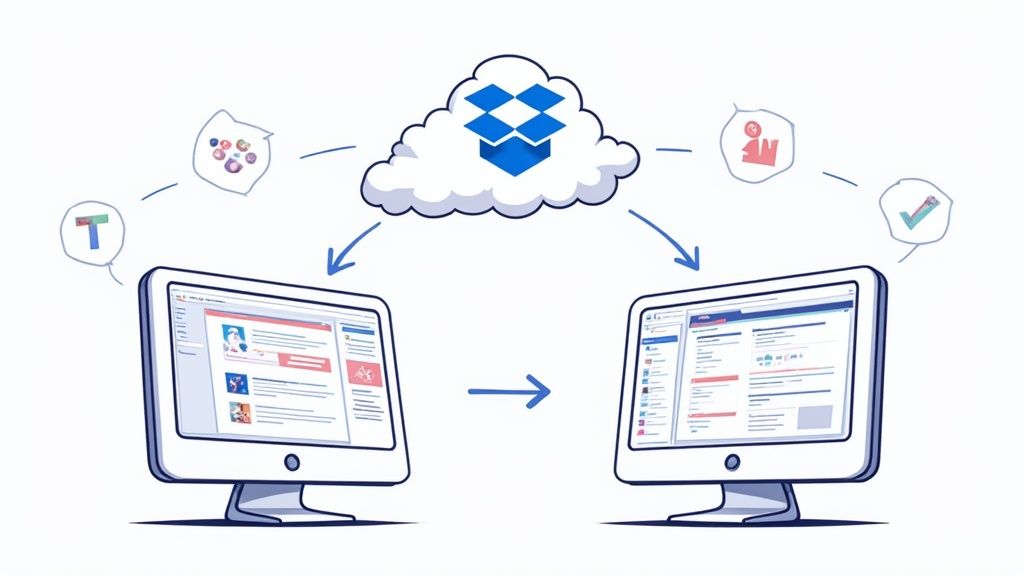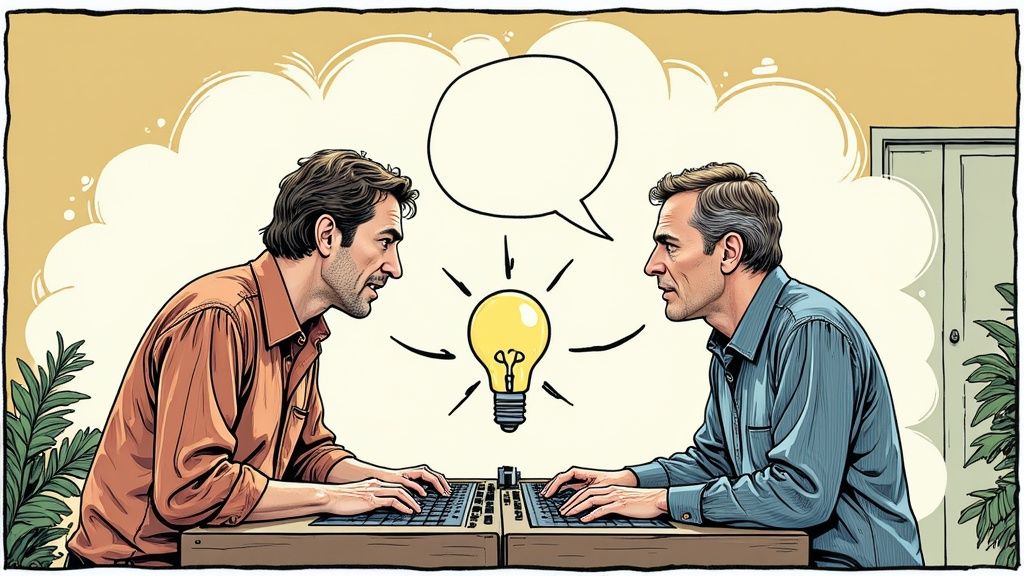Collaboration in music is really just two or more artists jumping into the studio (or a Zoom call) to create something together. It’s about blending unique skills and creative visions to make a single track. But it's so much more than just slapping a "feat." credit on a song title; it's a genuine driver of innovation that can expand your reach and push everyone involved into new creative territory.
Often, the final track ends up being something bigger and better than what any one person could have made on their own.

Artists joining forces is nothing new, but its importance has absolutely skyrocketed. What used to be a logistical nightmare of flying people out and booking studio time is now a seamless part of the everyday creative workflow. Technology has completely erased geographical lines.
These days, a producer in Berlin can be crafting beats with a vocalist in Lagos without them ever needing to be in the same room.
This shift has turned collaboration in music from a cool creative choice into a core strategy for anyone serious about their career. It’s about more than just combining fanbases—it's a powerful tool for artistic growth, discovery, and staying relevant.
One of the most exciting things to come out of all this is the explosion of genre-blending partnerships. When artists from completely different musical worlds get together, they almost always create something fresh and unexpected. Just think about a folk singer laying down vocals over a drill beat, or a jazz pianist improvising over a synth-pop track.
These kinds of unexpected pairings do a few key things really well:
This isn't just a vibe, either. The numbers back it up. We're seeing massive growth in global music markets, with revenues rising in regions like Sub-Saharan Africa (24.7%), Latin America (19.4%), and Asia (14.9%). A lot of that growth is fueled by cross-cultural projects that blend styles and become global hits.
The best idea wins. Modern collaboration is less about individual ego and more about serving the song. This mindset opens the door to experimentation and often leads to the most compelling musical moments.
Beyond all the creative wins, collaborations are a seriously potent marketing tool. Let's be real, the market is crowded. A joint release instantly doubles your promotional power.
Both artists share the track with their own audiences, creating a ripple effect that amplifies your reach far beyond what a solo release could ever hope to achieve. For indie artists especially, figuring out how to promote music online is a constant battle, and collabs give you a huge built-in advantage.
This shared effort helps you cut through the noise, making your music way more discoverable on streaming platforms and social media. It's a strategic move that builds community, expands your network, and ultimately, helps your music find the audience it deserves.
Great collaborations don't just happen. They start long before you ever drag a file into your DAW, with the search for someone whose creative vision and skills actually click with yours.
Spamming a hundred artists with generic DMs is a surefire way to get ignored. What works? A thoughtful, almost surgical approach to finding the right person. Think of it like casting for a movie—you're not just looking for any actor, you're looking for the perfect one for the role. Forget follower counts. Focus on their craft: their production style, vocal tone, or how they structure a song.
Your next creative partner is probably already on the platforms you use every day. The trick is to shift from being a passive listener to an active scout.
These platforms are your hunting grounds. The key is to approach it with a clear strategy.

This isn't about numbers; it's about making a genuine connection. A quality-over-quantity mindset will save you a ton of time and lead to outreach that actually gets a response.
To help narrow down your options, here's a quick look at a few more platforms where you might find your next collaborator.
Each platform has its own flavor. Think about what you need—a session guitarist for a single track, or a long-term production partner—and choose the right tool for the job.
Okay, you’ve found someone. Their sound is incredible, and you can already hear how your styles would mesh. Now what? Your first message is everything.
Please, for the love of music, avoid the generic "wanna collab?" message. It's the fastest way to the trash folder. Personalization is non-negotiable.
Start with something specific that you genuinely liked about their work. For instance: "Hey, just heard your track 'Midnight Drive' and the synth textures are insane. The way you layered those pads created such a cool atmosphere." This instantly shows you’ve actually listened and aren't just spamming.
"I usually start by making a list of people I’d love to work with. As demos come together, I reach out to them... a good amount of features on this record happened remotely. It takes a lot of back and forth, and sometimes months to get a track done." - CARRTOONS
Next, briefly introduce yourself. Link them to one or two of your absolute best tracks that fit their vibe. Don't send your entire SoundCloud profile. You need a quick, powerful sample of what you do.
Wrap it up with a clear, low-pressure call to action. Something like, "If you're ever open to working on something, I'd love to bounce some ideas around." It’s respectful of their time and opens the door for a real conversation. That’s how you build a partnership, not just a one-off feature.
Alright, you've found a collaborator. That's the easy part. The real work starts when you’re trying to build a track together from two different places.
A solid remote workflow is about more than just having the right software. It’s about building a system that keeps the creative juice flowing and stops a simple miscommunication from killing the whole vibe. I've seen promising tracks fall apart under the weight of disorganized files and missed messages. It happens all the time.
The backbone of any good remote project is a shared digital space. Think of it as your virtual studio. To get this right, you’ll need to explore some of the collaboration tools for remote teams out there. They're built to handle file sharing, communication, and keeping tasks straight so everyone stays on the same page.
First up, you have to decide on a Digital Audio Workstation (DAW). Most of us have our personal favorites, like Ableton or Logic, and that's cool. But for real-time collaboration, cloud-based DAWs have completely changed the game.
Platforms like Soundtrap let multiple people jump into the same project file at the same time. Seriously, it's like a Google Doc for music. This instantly gets rid of the soul-crushing back-and-forth of emailing project files. If you prefer to stick with standalone software, no worries—our guide on the best free digital audio workstation software can help you find solid options without breaking the bank.

This screenshot gives you a feel for how a cloud-based DAW works. Everything is laid out clearly—tracks, collaborators, you name it. It makes the whole process transparent and keeps the project moving, no matter where you are.
Beyond the DAW, you need a couple of other key tools:
Look, tech is great, but it can't fix human problems. That's why having a project kick-off call is non-negotiable.
This whole shift to digital collaboration in music is way more than just new software. It’s a total change in how we connect and create. Today, something like 70% of independent artists have worked digitally with people they've never even met in person.
So, before anyone records a single note, hop on a call. You need to hash out the details. A clear understanding of roles, responsibilities, and how you're going to talk to each other is the secret sauce for a smooth workflow.
The Collaboration Kick-off Checklist
- Project Vision: What are we actually making? Define the genre, the mood, and throw some reference tracks in a playlist.
- Roles & Responsibilities: Who's the lead producer? Who's handling arrangement? And who gets the final say on the mix?
- Communication: How are we talking? WhatsApp? Slack? What’s a reasonable time to expect a reply?
- File Management: How are we naming files? Something like
TrackName_Vocal_Take1_BPM120works wonders. And where do the final versions go?- Deadlines: What are the key milestones? Let's get some dates on the calendar.
Agreeing on this stuff upfront prevents so much friction down the road. It keeps all that creative energy focused on what actually matters: making great music.

Let's get one thing straight: creative friction is going to happen. In any kind of collaboration in music, it's not just inevitable—it's often the spark that takes a good idea and makes it great.
The real trick is knowing how to handle it. When egos get checked at the door and everyone’s focus stays on the song, a disagreement can become a breakthrough moment. The goal isn’t to sidestep conflict, but to channel it into something productive.
It all boils down to creating an environment where every idea gets a fair hearing, even if you’re clashing over a chord progression or a drum fill. This takes some real communication chops, especially when you can’t read body language in a room together. Learning some essential conflict resolution techniques can turn those creative roadblocks into genuine opportunities.
Delivering feedback is a delicate art. Forget the old "feedback sandwich"—a compliment, the critique, then another compliment. It usually comes off as fake.
Be direct, but be empathetic. Always frame your feedback around what’s best for the song, not the person.
This simple shift keeps the whole conversation objective and pointed toward the same goal.
The best idea wins. That’s the mantra. Modern collaboration is all about serving the song, not individual egos. This mindset opens you up to experimentation, and that’s where the magic usually happens.
So what happens when you hit a wall? You’re convinced the chorus needs a massive synth lead, but your partner is dead set on a gritty, distorted bassline. You’ve argued your points, and you’re at a total standstill.
Stop debating. Start testing.
Here are a few ways to break a creative deadlock without torching your partnership:
The A/B Test: Don't talk about it, build it. Mock up two quick versions of the section. Version A gets the synth lead, Version B gets the bassline. Drop them into the track and listen. Nine times out of ten, hearing the ideas in context makes the right path obvious.
Assign a Tie-Breaker: This is something you should figure out before the project even starts. Decide who gets the final say on certain things. Maybe the producer has the final call on arrangement, and the vocalist has the final word on lyrics. This structure takes ego out of the equation when you get stuck.
Bring in a Third Ear: Sometimes you're just too deep in the weeds to see clearly. Bounce the A/B versions off a trusted, neutral party—another producer, a musician friend, anyone whose opinion you respect. A fresh perspective can break the tie and often points out something you both completely missed.
Alright, you've gone back and forth, you’ve found that creative spark with your partner, and the song is really taking shape. It feels about 95% there. This is the moment a good song has the potential to become a great one.
That last 5% isn't about throwing more ideas at the wall. It’s about technical precision. It’s about making sure all the hard work you both put in actually translates perfectly when someone presses play. This is where you shift gears from pure creator to technical finisher, prepping the track for either a professional mix engineer or for you to handle the final mixdown yourself.
Before you even touch an EQ or compressor for the final mix, you need to get your session files in order. This means bouncing everything down into individual audio files—what we call "stems." If you're handing this project off to an engineer, this isn't just a suggestion; it's a non-negotiable step.
A clean, organized handoff means a smoother process and, ultimately, a better-sounding record. Here’s what that looks like in the real world:
Kick_Drum.wav and Lead_Vocal_Dry.wav are infinitely more useful than Audio_01_final_final.wav.This kind of meticulous organization saves a mix engineer a ton of time and headache, letting them jump right into the creative part of mixing. It’s also a great practice to include your latest rough mix and a couple of reference tracks to give them a clear idea of the sonic neighborhood you're aiming for.
Deciding whether to hire a mix engineer often comes down to budget and objectivity. After listening to a track hundreds of times, you become deaf to its flaws. A fresh set of professional ears can spot issues you've completely missed and give the track the final polish it needs to stand on its own.
Once you have a mix that you’re happy with, there's one last crucial test: checking how it translates across different listening systems. A mix can sound absolutely massive in your studio headphones but completely fall apart in a car or on a cheap Bluetooth speaker.
The car test is legendary for a reason—it’s the ultimate real-world stress test. Car stereos have their own weird EQ curves and acoustic environments that are mercilessly good at exposing flaws in a mix, especially in the low end. Suddenly, boomy bass, phasing problems, and a muddy midrange that you never noticed before become painfully obvious.
And remember, a great mix can't save a bad recording. If you're building out your setup, investing in quality gear from the start pays off big time. Exploring the best microphones for home recording vocals can make a world of difference before you even get to the mixing stage.
This is exactly why a tool like CarMaster is so essential. It’s built specifically to solve this problem, letting you hear how your track will hold up on various car audio systems. It ensures your bass stays tight and your mix remains clear and punchy, not just in your perfect studio environment, but out on the road where most people are actually listening. This final check is what protects all your hard work from sounding amateurish in the place it's most likely to be heard.
A killer track is built on creative energy, but a lasting partnership? That’s built on a solid business foundation. It's easily the least exciting part of making music, but getting the legal side of your collaboration sorted out from the jump is what protects both your work and your friendships.
Even if you're working with your best friend, you absolutely need a clear, written agreement. An awkward five-minute conversation today can save you from a friendship-ending, expensive legal nightmare down the road. This isn’t about mistrust; it’s about having professional respect for each other and the music you’re pouring your souls into.
Before you even bounce the final track, you need to talk about who owns what. This is where most future conflicts start, and it's completely avoidable. The key is to be upfront and fair, getting everything documented before emotions or money cloud the picture.
There are three main pieces to the puzzle:
A simple email chain confirming the agreed-upon splits can act as a basic contract. It might not be as ironclad as a formal legal document, but it’s a hundred times better than a verbal "we'll figure it out later."
And don't sleep on the earning potential here. We're seeing huge growth in global music markets. Recorded music revenues in regions like the Middle East and North Africa (MENA) shot up by 22.8% in 2024, mostly driven by streaming. Having your ownership documented is the only way to ensure you get your fair slice of that pie. You can read more about the latest trends in the global music industry to see why this is so critical.
The single most essential tool for any collaboration in music is the humble split sheet. It’s basically a simple contract that lays out who contributed what and what percentage of the song each person owns. It’s a non-negotiable document that you should fill out for every single song you co-create.
A split sheet doesn't need to be some complex legal document. At a minimum, it should have:
This simple piece of paper is your best defense against future arguments. It clarifies ownership from day one and gives you the documentation you need to register the song with your PRO, making sure everyone gets paid what they're owed. Making this a standard part of your process builds trust, sets a professional tone, and lets you focus on what really matters—making incredible music together.
Protecting your mix is just as crucial as protecting your rights. A track can sound perfect in the studio but completely fall apart in a car, where most people actually listen. CarMaster is designed specifically to make sure your collaborative tracks translate perfectly to any car stereo, preventing the muddy bass and weird phase issues that can ruin a listener's experience. Don't let all your hard work get skipped—upload your song for a free preview and hear the difference for yourself.